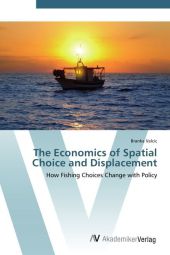 Neuerscheinungen 2012Stand: 2020-01-07 |
Schnellsuche
ISBN/Stichwort/Autor
|
Herderstraße 10
10625 Berlin
Tel.: 030 315 714 16
Fax 030 315 714 14
info@buchspektrum.de |

Branka Valcic
The Economics of Spatial Choice and Displacement
How Fishing Choices Change with Policy
Aufl. 2012. 172 S. 220 mm
Verlag/Jahr: AV AKADEMIKERVERLAG 2012
ISBN: 3-639-45357-3 (3639453573) / 3-8364-3756-2 (3836437562)
Neue ISBN: 978-3-639-45357-7 (9783639453577) / 978-3-8364-3756-1 (9783836437561)
Preis und Lieferzeit: Bitte klicken
Revision with unchanged content. Fishery policy makers would often benefit from information on how a policy might change fishermen behavior before the policy is implemented. Discrete choice models may be used to make predictions about these potential chan ges. Most of the simulation work done so far, however, has not been valida ted. In this book, a discrete choice model of fishing location choices is estimated and used to simulate the impacts of a spatial policy on the behavior of fisher men. The simulated redistribution of fishing effort is then compared with the actual redistribution of effort that had occurred with the implementation of this policy. Results from the presented case study underline the inherent problem of the simulation not being able to capture the fundamental change in the nature of the choice problem that occurs with the change in policy. Addressing this problem will be important as discrete choice models continue to be used to inform policy makers. Anybody with an interest in understanding human choices related to the use of natural resources may benefit from reading this book. Fisheries managers, fisheries economists, and graduate students in fisheries economics may find it particularly useful.
Dr. Branka Valcic is an assistant professor of environmental and resource economics at the University of Alaska Fairbanks. She obtained her PhD from the Dep. of Agricultural and Resource Economics, Oregon State University. Her research focuses on understanding both spatial and temporalpatterns of the natural resource use inconditions of change.


